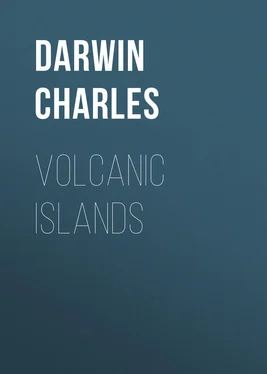Charles Darwin - Volcanic Islands
Здесь есть возможность читать онлайн «Charles Darwin - Volcanic Islands» — ознакомительный отрывок электронной книги совершенно бесплатно, а после прочтения отрывка купить полную версию. В некоторых случаях можно слушать аудио, скачать через торрент в формате fb2 и присутствует краткое содержание. Жанр: foreign_antique, foreign_prose, на английском языке. Описание произведения, (предисловие) а так же отзывы посетителей доступны на портале библиотеки ЛибКат.
- Название:Volcanic Islands
- Автор:
- Жанр:
- Год:неизвестен
- ISBN:нет данных
- Рейтинг книги:5 / 5. Голосов: 1
-
Избранное:Добавить в избранное
- Отзывы:
-
Ваша оценка:
- 100
- 1
- 2
- 3
- 4
- 5
Volcanic Islands: краткое содержание, описание и аннотация
Предлагаем к чтению аннотацию, описание, краткое содержание или предисловие (зависит от того, что написал сам автор книги «Volcanic Islands»). Если вы не нашли необходимую информацию о книге — напишите в комментариях, мы постараемся отыскать её.
Volcanic Islands — читать онлайн ознакомительный отрывок
Ниже представлен текст книги, разбитый по страницам. Система сохранения места последней прочитанной страницы, позволяет с удобством читать онлайн бесплатно книгу «Volcanic Islands», без необходимости каждый раз заново искать на чём Вы остановились. Поставьте закладку, и сможете в любой момент перейти на страницу, на которой закончили чтение.
Интервал:
Закладка:
The fragments of scoriae, embedded in the crystalline calcareous basis, are of a jet black colour, with a glossy fracture like pitchstone. Their surfaces, however, are coated with a layer of a reddish-orange, translucent substance, which can easily be scratched with a knife; hence they appear as if overlaid by a thin layer of rosin. Some of the smaller fragments are partially changed throughout into this substance: a change which appears quite different from ordinary decomposition. At the Galapagos Archipelago (as will be described in a future chapter), great beds are formed of volcanic ashes and particles of scoriae, which have undergone a closely similar change.
THE EXTENT AND HORIZONTALITY OF THE CALCAREOUS STRATUM.
(FIGURE 2: SIGNAL POST HILL. (Section with A low and C high.)
A. – Ancient volcanic rocks.
B. – Calcareous stratum.
C. – Upper basaltic lava.)
The upper line of surface of the calcareous stratum, which is so conspicuous from being quite white and so nearly horizontal, ranges for miles along the coast, at the height of about sixty feet above the sea. The sheet of basalt, by which it is capped, is on an average eighty feet in thickness. Westward of Porto Praya beyond Red Hill, the white stratum with the superincumbent basalt is covered up by more recent streams. Northward of Signal Post Hill, I could follow it with my eye, trending away for several miles along the sea cliffs. The distance thus observed is about seven miles; but I cannot doubt from its regularity that it extends much farther. In some ravines at right angles to the coast, it is seen gently dipping towards the sea, probably with the same inclination as when deposited round the ancient shores of the island. I found only one inland section, namely, at the base of the hill marked A, where, at the height of some hundred feet, this bed was exposed; it here rested on the usual compact augitic rock associated with wacke, and was covered by the widespread sheet of modern basaltic lava. Some exceptions occur to the horizontality of the white stratum: at Quail Island, its upper surface is only forty feet above the level of the sea; here also the capping of lava is only between twelve and fifteen feet in thickness; on the other hand, at the north-east side of Porto Praya harbour, the calcareous stratum, as well as the rock on which it rests, attain a height above the average level: the inequality of level in these two cases is not, as I believe, owing to unequal elevation, but to original irregularities at the bottom of the sea. Of this fact, at Quail Island, there was clear evidence in the calcareous deposit being in one part of much greater than the average thickness, and in another part being entirely absent; in this latter case, the modern basaltic lavas rested directly on those of more ancient origin.
Under Signal Post Hill, the white stratum dips into the sea in a remarkable manner. This hill is conical, 450 feet in height, and retains some traces of having had a crateriform structure; it is composed chiefly of matter erupted posteriorly to the elevation of the great basaltic plain, but partly of lava of apparently submarine origin and of considerable antiquity. The surrounding plain, as well as the eastern flank of this hill, has been worn into steep precipices, overhanging the sea. In these precipices, the white calcareous stratum may be seen, at the height of about seventy feet above the beach, running for some miles both northward and southward of the hill, in a line appearing to be perfectly horizontal; but for a space of a quarter of a mile directly under the hill, it dips into the sea and disappears. On the south side the dip is gradual, on the north side it is more abrupt, as is shown in Figure 2. As neither the calcareous stratum, nor the superincumbent basaltic lava (as far as the latter can be distinguished from the more modern ejections), appears to thicken as it dips, I infer that these strata were not originally accumulated in a trough, the centre of which afterwards became a point of eruption; but that they have subsequently been disturbed and bent. We may suppose either that Signal Post Hill subsided after its elevation with the surrounding country, or that it never was uplifted to the same height with it. This latter seems to me the most probable alternative, for during the slow and equable elevation of this portion of the island, the subterranean motive power, from expending part of its force in repeatedly erupting volcanic matter from beneath this point, would, it is likely, have less force to uplift it. Something of the same kind seems to have occurred near Red Hill, for when tracing upwards the naked streams of lava from near Porto Praya towards the interior of the island, I was strongly induced to suspect, that since the lava had flowed, the slope of the land had been slightly modified, either by a small subsidence near Red Hill, or by that portion of the plain having been uplifted to a less height during the elevation of the whole area.
THE BASALTIC LAVA, SUPERINCUMBENT ON THE CALCAREOUS DEPOSIT.
This lava is of a pale grey colour, fusing into a black enamel; its fracture is rather earthy and concretionary; it contains olivine in small grains. The central parts of the mass are compact, or at most crenulated with a few minute cavities, and are often columnar. At Quail Island this structure was assumed in a striking manner; the lava in one part being divided into horizontal laminae, which became in another part split by vertical fissures into five-sided plates; and these again, being piled on each other, insensibly became soldered together, forming fine symmetrical columns. The lower surface of the lava is vesicular, but sometimes only to the thickness of a few inches; the upper surface, which is likewise vesicular, is divided into balls, frequently as much as three feet in diameter, made up of concentric layers. The mass is composed of more than one stream; its total thickness being, on an average, about eighty feet: the lower portion has certainly flowed beneath the sea, and probably likewise the upper portion. The chief part of this lava has flowed from the central districts, between the hills marked A, B, C, etc., in the woodcut- map. The surface of the country, near the coast, is level and barren; towards the interior, the land rises by successive terraces, of which four, when viewed from a distance, could be distinctly counted.
VOLCANIC ERUPTIONS SUBSEQUENT TO THE ELEVATION OF THE COASTLAND; THE EJECTED MATTER ASSOCIATED WITH EARTHY LIME.
These recent lavas have proceeded from those scattered, conical, reddish- coloured hills, which rise abruptly from the plain-country near the coast. I ascended some of them, but will describe only one, namely, RED HILL, which may serve as a type of its class, and is remarkable in some especial respects. Its height is about six hundred feet; it is composed of bright red, highly scoriaceous rock of a basaltic nature; on one side of its summit there is a hollow, probably the last remnant of a crater. Several of the other hills of this class, judging from their external forms, are surmounted by much more perfect craters. When sailing along the coast, it was evident that a considerable body of lava had flowed from Red Hill, over a line of cliff about one hundred and twenty feet in height, into the sea: this line of cliff is continuous with that forming the coast, and bounding the plain on both sides of this hill; these streams, therefore, were erupted, after the formation of the coast-cliffs, from Red Hill, when it must have stood, as it now does, above the level of the sea. This conclusion accords with the highly scoriaceous condition of all the rock on it, appearing to be of subaerial formation: and this is important, as there are some beds of calcareous matter near its summit, which might, at a hasty glance, have been mistaken for a submarine deposit. These beds consist of white, earthy, carbonate of lime, extremely friable so as to be crushed with the least pressure; the most compact specimens not resisting the strength of the fingers. Some of the masses are as white as quicklime, and appear absolutely pure; but on examining them with a lens, minute particles of scoriae can always be seen, and I could find none which, when dissolved in acids, did not leave a residue of this nature. It is, moreover, difficult to find a particle of the lime which does not change colour under the blowpipe, most of them even becoming glazed. The scoriaceous fragments and the calcareous matter are associated in the most irregular manner, sometimes in obscure beds, but more generally as a confused breccia, the lime in some parts and the scoriae in others being most abundant. Sir H. De la Beche has been so kind as to have some of the purest specimens analysed, with a view to discover, considering their volcanic origin, whether they contained much magnesia; but only a small portion was found, such as is present in most limestones.
Читать дальшеИнтервал:
Закладка:
Похожие книги на «Volcanic Islands»
Представляем Вашему вниманию похожие книги на «Volcanic Islands» списком для выбора. Мы отобрали схожую по названию и смыслу литературу в надежде предоставить читателям больше вариантов отыскать новые, интересные, ещё непрочитанные произведения.
Обсуждение, отзывы о книге «Volcanic Islands» и просто собственные мнения читателей. Оставьте ваши комментарии, напишите, что Вы думаете о произведении, его смысле или главных героях. Укажите что конкретно понравилось, а что нет, и почему Вы так считаете.












